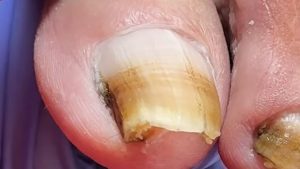
1. Ingrown Toenail (Onychocryptosis)
An ingrown toenail occurs when the edge of the toenail grows into the surrounding skin, usually on the big toe. This can cause redness, swelling, pain, and sometimes an infection if bacteria enter the area.
Causes:
- Improper nail trimming: Cutting nails too short or rounding the edges can lead to the nail growing into the skin.
- Tight shoes: Wearing shoes that are too tight or too narrow can put pressure on the toes and encourage the nail to grow improperly.
- Injury: Stubbing or damaging the toenail can cause it to grow abnormally.
- Genetics: Some people are naturally more prone to ingrown nails due to the shape of their nails.
Symptoms:
- Pain at the edge of the toenail, especially when touched or pressure is applied.
- Swelling, redness, and warmth around the nail.
- If infected, pus may be seen coming from the area.
Treatment:
- Home care: Soaking the foot in warm, soapy water for 15–20 minutes a few times a day can reduce swelling and soften the skin around the toenail.
- Proper trimming: After soaking, carefully trim the toenail straight across to avoid further irritation.
- Cotton or dental floss: Placing a small piece of clean cotton or dental floss between the toenail and skin can help the nail grow above the skin rather than into it.
- Over-the-counter pain relief: Nonsteroidal anti-inflammatory drugs (NSAIDs) like ibuprofen can help reduce pain and inflammation.
Medical Treatment:
If home care doesn’t resolve the issue or if there’s a risk of infection, you may need to see a podiatrist or doctor. They may:
- Partial nail removal: In some cases, the doctor may need to remove part of the toenail that’s growing into the skin.
- Chemical treatment: A chemical may be applied to the nail bed to prevent the toenail from growing back in the same way.
- Full nail removal: In more severe or recurrent cases, the entire toenail might need to be removed.
2. Fungal Toenail Infection (Onychomycosis)
Fungal infections can cause the toenail to thicken, become discolored (often yellow or white), and sometimes crumble or separate from the nail bed. This condition is typically caused by fungi such as dermatophytes.
Causes:
- Moist, warm environments: Fungi thrive in damp, dark places, so wearing tight shoes, sweaty socks, or walking barefoot in public places like pools or gyms increases the risk.
- Previous injury to the toenail: A nail that has been injured is more vulnerable to infection.
- Poor hygiene: Not keeping your feet clean and dry increases the chances of developing a fungal infection.
- Weakened immune system: People with diabetes or compromised immune systems are more likely to get fungal infections.
- Family history: Fungal infections can run in families.
Symptoms:
- Discoloration of the nail, usually yellow, white, or brown.
- Thickened, brittle, or crumbling nails.
- Separation of the nail from the nail bed.
- Sometimes a foul odor from the infected nail.
Treatment:
- Topical antifungal treatments: These include over-the-counter creams, ointments, or nail lacquers (like ciclopirox or undecylenic acid). These are often applied directly to the nail and surrounding skin.
- Oral antifungal medications: For more severe cases, oral antifungal medications like terbinafine or itraconazole may be prescribed to help the fungus from the inside out. Treatment typically lasts 6–12 weeks.
- Laser treatment: Some healthcare providers offer laser therapy to treat fungal toenail infections. The laser targets the fungi and helps clear up the infection.
- Surgical removal of the nail: In very severe or persistent cases, the infected toenail may be removed, allowing new, healthy nail growth to occur.
Preventive Measures:
- Keep your feet clean and dry.
- Wear breathable shoes and socks that wick moisture away.
- Avoid walking barefoot in public spaces like showers or pools.
- Change socks regularly, especially if your feet sweat a lot.
- Use antifungal powder or sprays in your shoes to prevent fungal growth.
When to See a Doctor
- If you experience severe pain, redness, or swelling that doesn’t go away.
- If there’s a discharge of pus or if the toenail becomes infected.
- If you have a recurring ingrown toenail or fungal infection.
- If home treatments don’t seem to be working, or if the condition worsens.
General Tips for Toenail Care:
- Trim your nails straight across to avoid ingrown nails.
- Avoid tight shoes that can press on the toes.
- Keep your feet clean and dry to prevent fungal infections.
- Use a pumice stone to remove any thickened skin around the nail to help with circulation.
- Be cautious with sharp objects around the toenail; always trim carefully.
Does this help clear things up for you, or would you like to dive deeper into any of these conditions?
https://youtu.be/3cOz6lp1slM?si=e200ReyrG2e3WcMP


